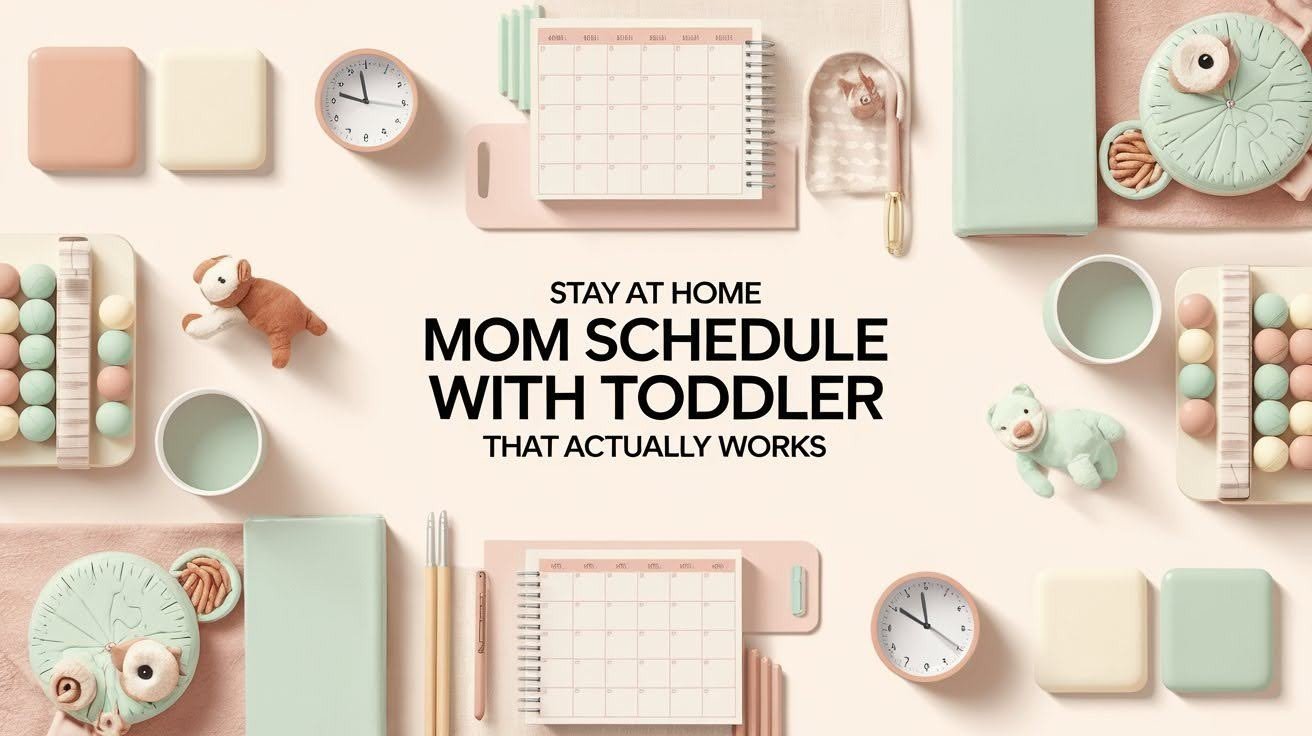I sat at the bottom of my basement stairs crying at 10 AM while my 2-year-old whined endlessly upstairs. My husband rushed from his office, thinking someone was hurt.
But it was just me, emotionally drained before lunch, unable to figure out why nothing was working.
If you’re a stay-at-home mom struggling with chaotic days and constant meltdowns, you’re not alone.
As a Ph.D. in Human Development, I’ve learned that creating a stay-at-home mom schedule with a toddler isn’t about perfection it’s about finding balance.
This research-backed approach will help you establish routines that support your toddler’s development while preserving your sanity.
The Perfect Stay-at-Home Mom Schedule with Toddler
The key to a successful stay-at-home mom schedule with a toddler lies in balancing structured activities with flexibility. This sample schedule provides a framework that works for most families.
Morning Routine (7:00 AM – 10:00 AM)
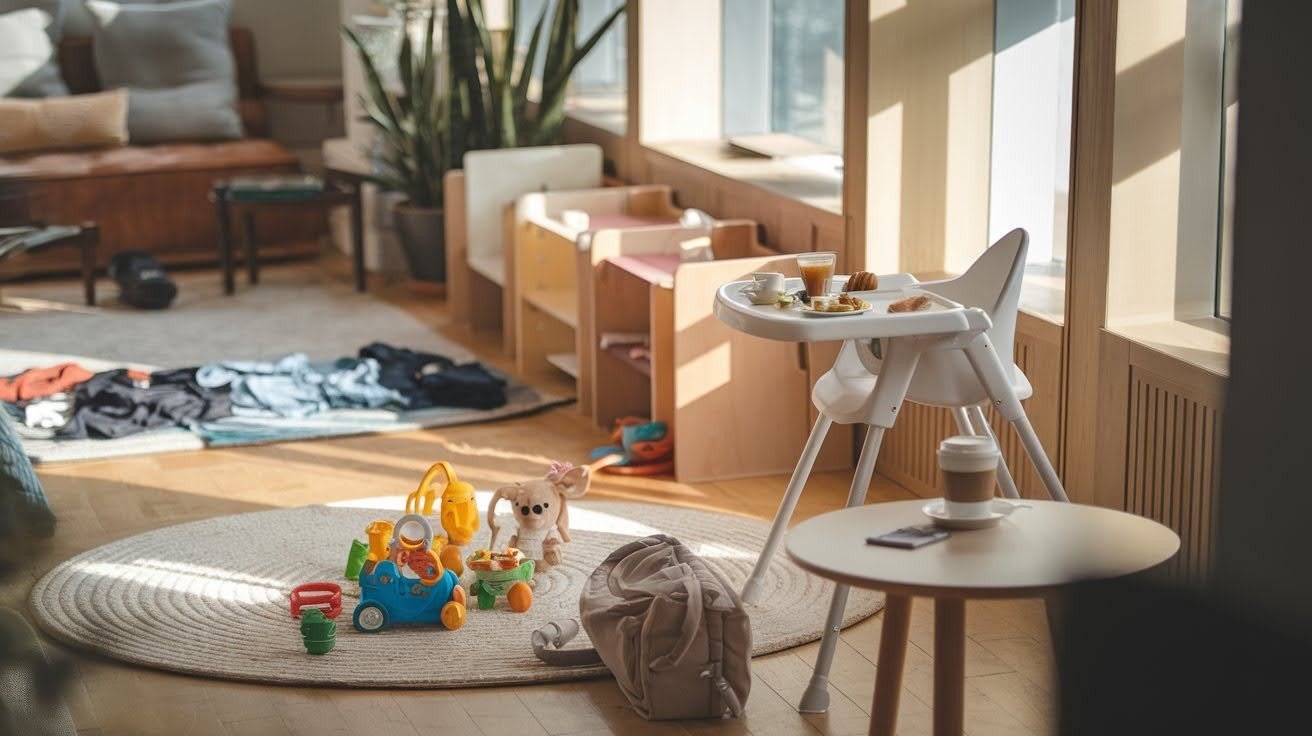
Start your day with coffee while your toddler eats breakfast and plays independently. Put on music to create a cozy morning atmosphere before the day’s activities begin.
Getting everyone ready works best when you prepare the night before by laying out clothes and packing your diaper bag. One parent can head to the gym while the other handles morning prep.
Use your toddler’s screen time strategically while you shower and get ready for the day. This 30-45 minute window allows you to prepare without constant interruptions while your child enjoys educational content.
Structured Activity Time (10:00 AM – 11:30 AM)
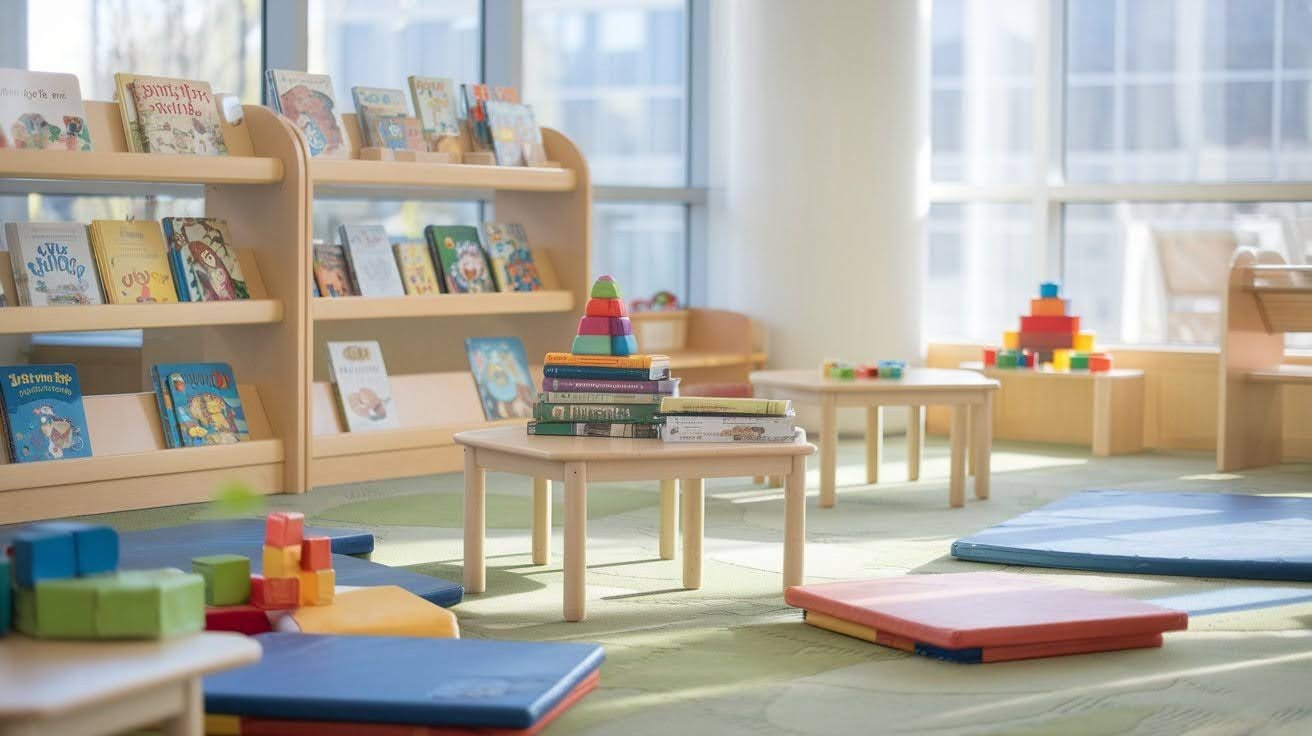
Getting out of the house daily is crucial for both your mental health and your toddler’s development. Plan one structured activity each weekday, whether it’s library story time, playground visits, or gym classes.
Library programs offer incredible value with free story times, educational toys, and opportunities to meet other families. Many libraries have different programs throughout the week, giving you multiple options.
The goal is to spend 60-90 minutes away from home in a stimulating environment. This change of scenery prevents cabin fever while providing your toddler with new experiences and social opportunities.
Midday Rest and Reset (11:30 AM – 2:30 PM)

Lunch should happen around the same time daily to maintain your toddler’s internal clock. Keep meals simple but nutritious, and use this time for conversation and connection.
Nap time from 12:30-2:30 PM works well for most toddlers and gives you essential downtime. Consistent nap timing helps regulate your child’s sleep patterns while providing you with time to recharge.
Even if your toddler doesn’t sleep, enforcing quiet time in their room with books or soft music benefits everyone. This break in stimulation helps prevent afternoon meltdowns.
Afternoon Energy Release (2:30 PM – 5:30 PM)
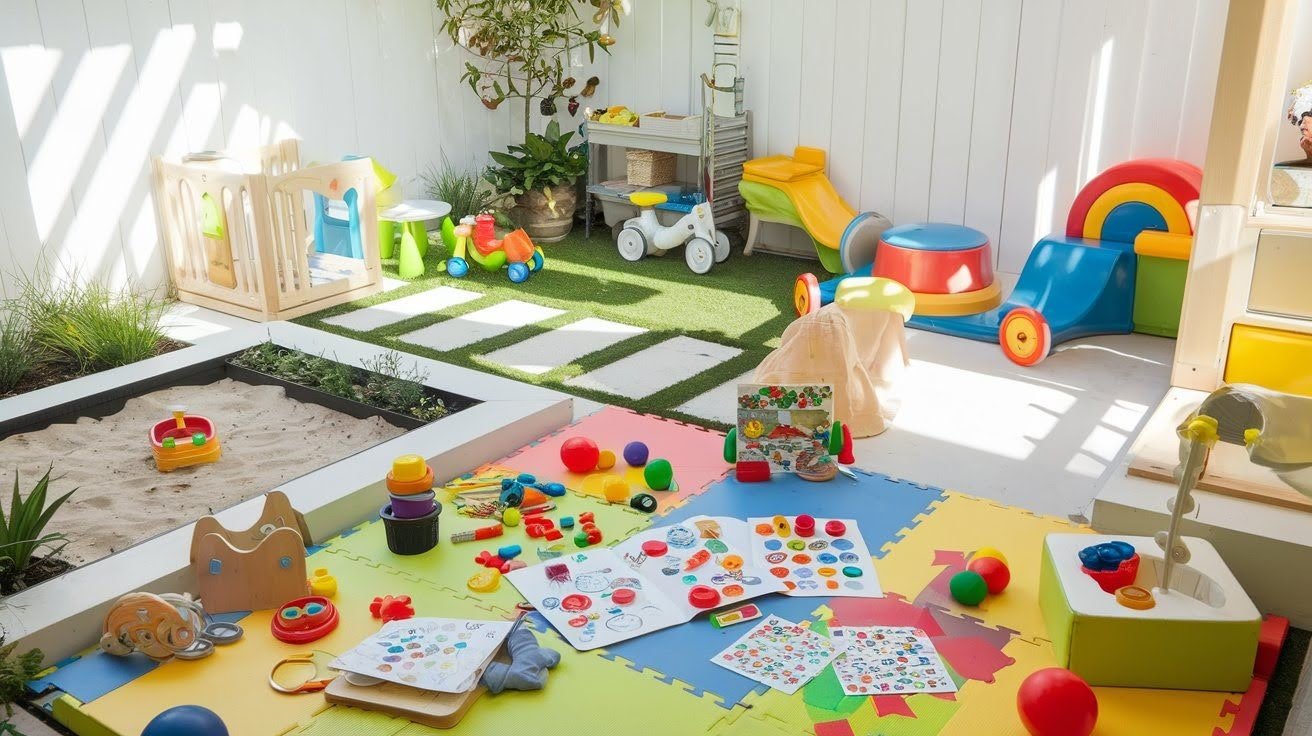
Post-nap snacks and independent play activities help your toddler transition back to active time. Set up simple activities like coloring, sticker books, or Play-Doh to keep them engaged.
Outdoor time is essential for burning energy and getting fresh air. Visit your neighborhood playground, take a walk, or simply play in the backyard to help your toddler release energy.
When the weather doesn’t permit outdoor play, create indoor alternatives like dance parties, obstacle courses, or sensory bins. The key is providing physical movement opportunities.
Evening Wind-Down (5:30 PM – 8:00 PM)
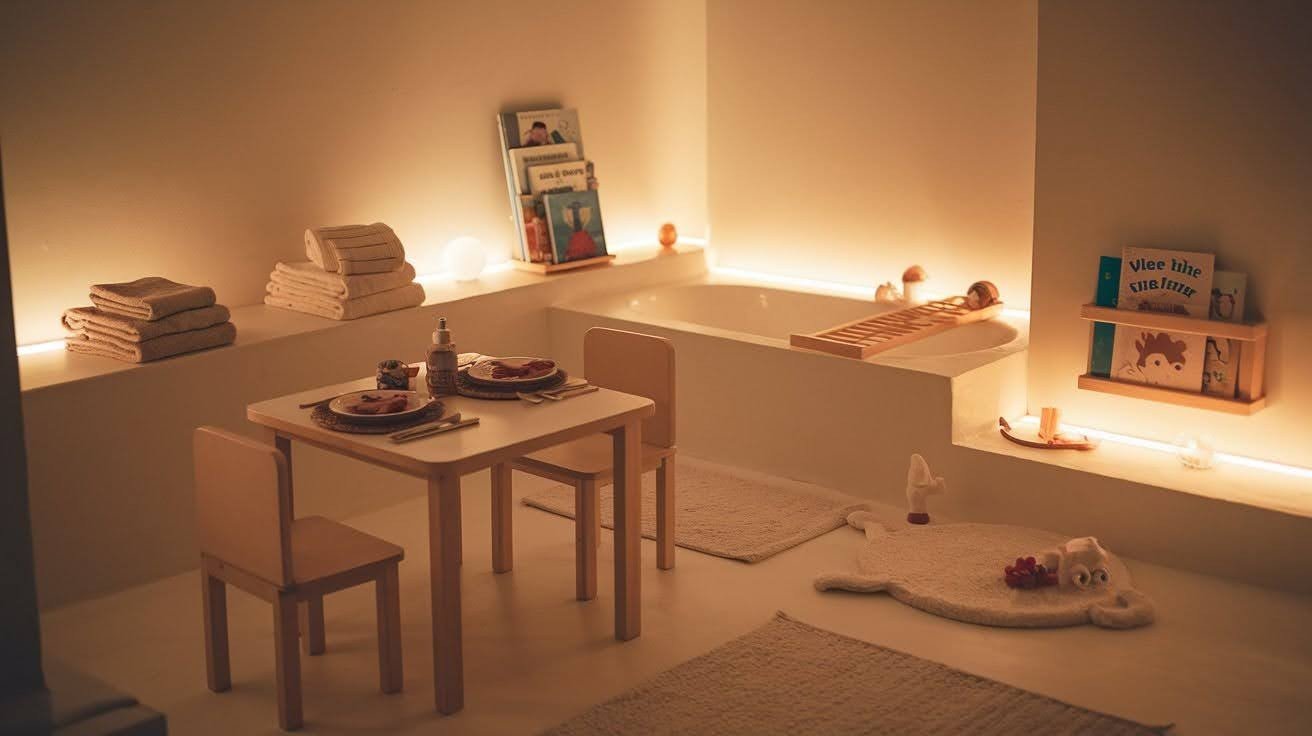
Family dinner time around 5:30 PM works well for toddler bedtimes and allows everyone to eat together. Keep meals simple and focus on connection rather than perfect table manners.
Bath time serves as both hygiene and a transition to bedtime mode. Let your toddler play with bath toys while you clean them, making this routine enjoyable.
Your bedtime routine should include reading books, saying prayers or expressing gratitude, and singing lullabies. These consistent rituals signal that sleep time is approaching and help children feel secure.
Why Schedules Matter for Toddler Development?
Research consistently shows that predictable routines support healthy brain development and emotional regulation in young children. A well-structured stay-at-home mom schedule with a toddler creates the foundation for lifelong learning.
Building Security Through Predictability
Toddlers thrive when they know what to expect throughout their day. Consistent routines create emotional safety by reducing anxiety and helping children feel confident about their environment.
Studies show that children with predictable schedules develop better self-regulation skills and experience fewer behavioral problems. When toddlers can anticipate meal times and activities, they feel more secure.
The trust built through reliable routines strengthens your parent-child bond and creates a foundation for healthy emotional development. Your consistency teaches your toddler that the world is safe.
Supporting Key Developmental Areas
Reading together daily builds vocabulary, comprehension, and emotional intelligence in ways that isolated learning cannot match. Books give toddlers words to describe their feelings and experiences.
Pretend play develops crucial social-emotional skills that benefit children throughout their lives. When toddlers engage in imaginative play, they learn empathy, problem-solving, and positive social interaction.
Physical activities support your toddler’s rapid growth and help them master new motor skills. Regular movement opportunities improve coordination, strength, and body awareness while providing healthy energy outlets.
Best Activities to Include in Your Toddler Schedule
Choosing the right activities for your stay-at-home mom schedule with a toddler doesn’t require a huge budget or elaborate planning. Focus on opportunities that promote development while keeping both of you engaged.
Free Community Resources

Library story times offer incredible value with professional storytellers, songs, and educational activities. Most libraries also have play areas with toys specifically chosen for developmental benefits.
Playgrounds provide essential physical activity opportunities while letting you connect with other parents. Vary your locations to keep things interesting and give your toddler different challenges.
Home-based activities like sensory bins, art projects, and building blocks cost little but provide rich learning experiences. Rotate toys regularly to maintain your toddler’s interest.
Worth-the-Investment Paid Activities

Movement programs like The Little Gym offer structured physical activities that support gross motor development in ways that home play cannot match. These classes also provide social opportunities.
Parent-child classes create opportunities for you to exercise while your toddler plays nearby or participates in age-appropriate activities. Programs like Stroller Strides combine fitness with social connection.
Recreation centers often offer multiple programs under one membership, making them cost-effective choices for families wanting various activity options. Many also provide childcare during adult fitness classes.
Making Your Schedule Work Long-Term
The most effective stay-at-home mom schedule with a toddler adapts as your family grows and changes. Building flexibility into your routine ensures long-term success.
Customizing for Your Family’s Needs
Every toddler has different energy levels, attention spans, and interests that should influence your daily schedule. Some children need more physical activity, while others thrive with longer quiet periods.
Seasonal changes require schedule modifications to accommodate weather, daylight hours, and available activities. Summer might include more outdoor time, while winter schedules might feature more indoor creative activities.
Pay attention to your toddler’s natural rhythms and adjust timing accordingly. Some children are ready for activities earlier in the morning, while others need more time to wake up.
Building Your Mom Community
Meeting other parents through regular activities creates essential support networks for long-term success. These friendships provide practical help, emotional support, and social opportunities.
Consistent participation in community activities helps you build relationships gradually and naturally. Regular attendance at story time or playground visits creates opportunities for meaningful connections.
Having mom friends makes the stay-at-home experience less isolating and provides valuable resources for everything from activity recommendations to parenting advice. These relationships benefit your entire family.
Essential Tips for Happy Stay-at-Home Moms
Being a stay-at-home mom can be joyful but challenging. Balancing your toddler’s needs with your own well-being is important for a happy household. The following tips can help you stay connected with your child, manage daily tasks, and maintain calm and structure in your home.
- Connection Before Chores: Spend focused time with your toddler before starting household tasks. Even 15 minutes of undivided attention helps fill their emotional needs and encourages cooperation.
- Simple Connection Activities: Read together, build with blocks, or have a small dance session. Put away distractions and be fully present.
- Smart Multitasking with Double-Duty Activities: Choose activities that benefit both you and your child. Examples include walking while your toddler rides a tricycle, reading together, cooking, gardening, listening to music, or doing yoga stretches. These allow you to bond while accomplishing other goals.
- Setting Boundaries That Work: Establish a daily quiet time for calm, independent activities. Focus on teaching acceptable behaviors rather than suppressing emotions. It’s fine for your toddler to feel frustrated, but hitting or throwing is not allowed.
- Teaching Healthy Expression: Help your child express strong feelings safely. Offer options like deep breathing, hugging a stuffed toy, or using words to communicate needs.
Using these strategies helps create a balanced routine where both you and your toddler can feel happy, connected, and supported throughout the day.
Conclusion
A well-planned stay-at-home mom schedule with a toddler transforms chaotic days into manageable, enjoyable routines that benefit both you and your child. The key lies in balancing structure with flexibility while prioritizing connection.
Remember that perfect implementation isn’t the goal, progress is. Start with one element that feels manageable and build gradually as you and your toddler adjust to new routines.
Your consistency and love create daily magic in ordinary moments. Focus on what works for your family rather than comparing yourself to others.
Frequently Asked Questions
What If My Toddler Refuses To Nap During Scheduled Time?
Enforce quiet time in their room with books or soft music instead. Gradually transition by shortening nap expectations and watch for signs they’re outgrowing daytime sleep needs naturally.
How Do I Handle Schedule Disruptions Like Doctor Appointments?
Maintain key routine anchors like meal times and bedtime while staying flexible with activities. Return to your normal schedule the next day without overthinking temporary disruptions.
Is It Normal To Feel Guilty About Screen Time In My Schedule?
Yes, guilt is normal, but unnecessary when using screens strategically. Focus on age-appropriate, educational content and remember that your mental health matters for your family’s overall well-being.
What Should I Do When My Toddler Has Meltdowns During Activities?
Understand that meltdowns are normal developmental behavior, not personal failures. Prevent them through consistent scheduling and respond calmly with comfort rather than punishment or reasoning.
How Can I Afford Paid Activities On A Single Income?
Prioritize one paid activity that provides maximum value while utilizing free community resources like libraries and playgrounds. Look for recreation center memberships that include multiple program options.

